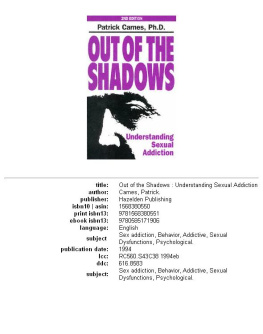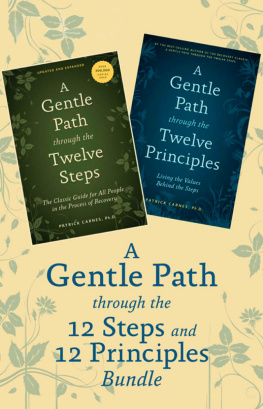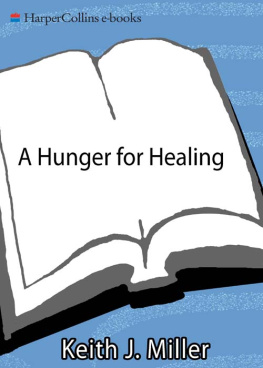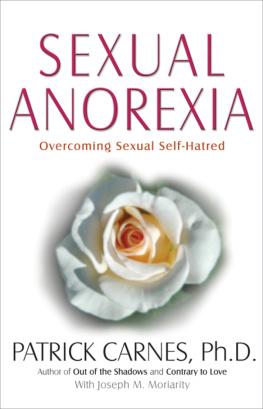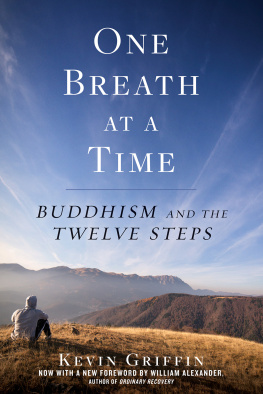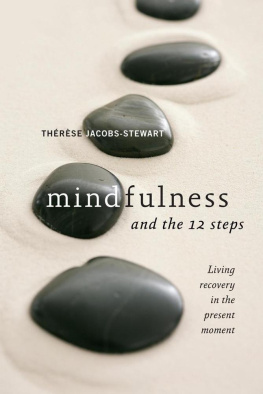A Gentle Path
through the
Twelve Steps
The Classic Guide for All People
in the Process of Recovery
UPDATED AND EXPANDED

Patrick Carnes, Ph.D.

Hazelden
Center City, Minnesota 55012
hazelden.org
1993, 2012 by Patrick J. Carnes, Ph.D.
All rights reserved. Updated and expanded edition published 2012 in both electronic and print formats.
First edition previously published by CompCare Publishers 1993.
First published by Hazelden Foundation 1994.
Produced in the United States of America.
No part of this electronic publication, or its printed work, may be reproduced in any form or by any means without the written permission of the publisher. Failure to comply with these terms may expose you to legal action and damages for copyright infringement
Library of Congress Cataloging-in-Publication Data
Carnes, Patrick, 1944
A gentle path through the twelve steps : the classic guide for all people in the process of recovery / Patrick J. Carnes.
p. cm.
Summary: The twelve steps tap into the essential human process of change and will be regarded as one of the intellectual and spiritual landmarks in human history. Patrick Carnes
It was out of his reverence and respect for the wisdom and therapeutic value of the Twelve Steps that Carnes wrote A Gentle Path through the Twelve Steps, now a recovery classic and self-help staple for anyone looking for guidance for lifes hardest challenges. Hundreds of thousands of people have found in this book a personal portal to the wisdom of the Twelve Steps. With updated and expanded concepts and a focus on the spiritual principles that lead to lifelong growth and fulfillment, Carnes new edition invites a fresh generation of readers to the healing and rewarding experience of Twelve Step recoveryProvided by publisher.
ISBN 978-1-59285-843-9 (pbk.)
ISBN 978-1-59285-996-2 (ebook)
1. Twelve-step programs. 2. Compulsive behavior. 3. AlcoholicsRehabilitation. 4. Drug addictsRehabilitation. I. Title.
BF632.C366 2012
616.8606dc23
2012006914
Editors note
This publication is not intended as a substitute for the advice of health care professionals.
Alcoholics Anonymous, AA, and the Big Book are registered trademarks of Alcoholics Anonymous World Services, Inc.
The Twelve Steps and Twelve Traditions are reprinted and adapted with permission of Alcoholics Anonymous World Services, Inc. Permission to reprint and adapt this material does not mean that AA has reviewed or approved the content of this publication, nor that AA agrees with the views expressed herein. AA is a program of recovery from alcoholism only. Use of the Twelve Steps and Twelve Traditions in connection with programs and activities which are patterned after AA, but which address other problems, does not imply otherwise.
Cover design by David Spohn

Introduction to the Updated and Expanded Edition
FOR NEARLY SEVENTY-FIVE years, the Twelve Steps have served as an extraordinary recipe for recovery. Since they were first published in the book Alcoholics Anonymous in 1939, they have had a profound impact far beyond the world of alcoholism, helping tens of millions of people with addictions of all types.
The Twelve Steps have been so useful and translatable because they tap into the essential human process of change and make that process more explicit, more understandable, and more sustainable. I believe that, a century from now, the Twelve Steps will be regarded as one of historys great intellectual and spiritual landmarksone that marked our emergence into a diverse, global society.
The central premise of this bookthat addiction manifests in many forms, extending far beyond drugs and alcoholseems self-evident to contemporary readers. We now know that sex, food, money, work, relationships, shopping, gambling, gaming, and many other aspects of life can all devolve into compulsive behavior, which is the essential component of addiction. We also know that the Twelve Steps can help people with any (or any combination) of these compulsions to recover.
Today we also know that having a combination of addictions is far more common than having only one. Eighty-seven percent of people with addictions have two or more. As one Twelve Step joke notes, if some addicts went to all the meetings they qualified for, theyd do nothing else with their lives.
Twenty-five years ago our awareness was much narrower. In 1987, when the first edition of this book was proposed to publishers, many folks objected heatedly to putting alcoholics and drug addictsor any two groups of people with different addictionstogether in the same room. Many professionals saw alcoholics as very different (and slightly more refined) than drug addicts. Most other forms of addiction were given no credence at all. When I went on Phil Donahues show to talk about sex addiction, the topic was widely perceived as a joke. Back then, looking at Twelve Step life as a wholeacross addictions and fellowshipswas considered a radically new, groundbreaking approach. It threatened many professionals and frightened most publishers, who also believed firmly that people wouldnt buy workbooks.
Eventually I found a publisher (not the current publisher) who would take the risk of publishing A Gentle Path through the Twelve Steps but only if I would also create a set of six audio tapes. The rationale was that the tapes would do well enough to jump-start sales of the bookor, failing that, to at least offset the publishers probable financial loss on the book.
Today, twenty-five years later, A Gentle Path through the Twelve Steps has sold over 350,000 copies worldwide and has become one of its current publishers top-selling books. As for the audio tapes, they did not sell well and have been unavailable for many years. Im not even sure where my own tapes are.
One of the hallmarks of A Gentle Path through the Twelve Steps has been that anybody can use it. It works for all kinds of addicts; it works for coaddicts; it doesnt matter what fellowship you are in. Each edition of the book provides a concrete, structured way to implement what the authors of Alcoholics Anonymous discovered and described in the 1930s. It gives readers a focused path for integrating the Twelve Steps into their lives in a practical, doable way. With each new edition, my goal has been to make that path clearer, more helpful, and more profound.
Today we know so much more about the science, psychology, and sociology of addiction than we did when the first edition of A Gentle Path appeared in the early 1990s. We know, for example, that addictions not only commonly exist together, but interact with and trigger each other. We know that the role of family members in recovery is deeply important, and improves addicts rates of recovery. When family membersparents, kids, and partnerscommit to recovery themselves, the probability of success increases dramatically for everyone.
Perhaps most importantly, we now know immeasurably more about how the brain changes than we did even a decade ago. For a full century, the biggest obstacle to creating effective mental health treatments was that we had no way to look closely at the organ we were treating. Now, through a variety of scanning techniques, we can view the brains activities in some detail. This has not merely deepened, but revolutionized our understanding of how recovery works. Indeed, these imaging techniques have verified and strengthened every part of the Twelve Step process. We now know that the basic neurology of recovery involves literally regrowing our brains, creating new and healthier ways of thinking, perceiving, and acting by building new neural pathways.
Next page

